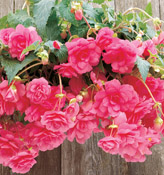Tips On How To Grow Begonias

Growing Begonias
It???s Easy to Grow Tuberous Begonias
Almost all homes have a place suitable for tuberous begonias. Places such as the north side of a building, under shade trees or in pots under a porch roof are perfect spots for planting begonias.
Growing Begonias From Tubers
Early Planting
Tuberous begonias are tender and cannot be placed outdoors until danger of frost is past. Start with any sized tuber. Tubers can be planted from February to June. In areas with hot summer temperatures it is best to have them well established before hot weather arrives. Tubers may be planted indoors about 8 weeks before transplanting outdoors.
1.) Fill a flat box or small pot with potting soil at least 2 ?? inches deep.
2.) Any porous, slightly acidic soil is satisfactory. Peat moss soil mixes are best to retain moisture and create slightly acidic conditions.
3.) Place the tubers hollow side up with the top just below the surface. Keep the soil moist but do not over-water before growth appears.
4.) Temperature of 72?? F is ideal but slightly higher or lower temperatures are ok. In 2-3 weeks, after the sprouts emerge, be sure to provide ample light. They may be transplanted to an outdoor location any time after good root development is apparent and top growth is not more than 4 to 5 inches tall.
Video on starting tuberous begonias in small pots.
Transplanting or Planting Directly Outdoors
Plant with 1-1.5??? soil covering the top of the tuber, in well-drained garden soil or large pots 8??? or larger. Larger pots will produce fuller plants and better stability. Multiple small tubers can be planted in a single pot. This works particularly well with hanging basket varieties. Depending on environmental conditions, begonias will bloom in 12 to 20 weeks after planting. Warmer soil temperatures may have the most influence on advancing growth and ultimately time to bloom.
Our recommendations on??how many tubers to plant in a pot.
Growing Begonias From Seed
Starting tuberous begonias from seed can be difficult and only recommend it to experienced begonia hobbyists. Learn more about seed germination of tuberous begonias.
Sunlight
Begonias do best in high filtered light throughout the day. In cooler climates begonias can tolerate more sun. An eastern exposure is acceptable, receiving full sun in the morning with afternoon shade. It is best not to plant in full shade.
Water
Begonias need to be kept moist at all times. Begonias prefer cool, moist conditions. Spraying plants with water on hotter days will help maintain cool conditions. Avoid saturating the soil, over saturating the soil will promote rot.
Fertilizer
Any mild fertilizer can be used at intervals throughout the season. A natural fertilizer such as fish emulsion is ideal. Use half rates if using chemical fertilizers to avoid salt burn. For best results, fertilize lightly in the first few weeks of planting to avoid an over-abundance of foliage growth and promote earlier bloom. Once blooms appear begin regular fertilization. We recommend using Romeo Plant Food.
Diseases
Begonias are susceptible to various fungi and bacteria. An environment with good airflow is essential to maintaining healthy plants. Prevention is the only cure for powdery mildew. Use fungicides only as directed on the label.
Natural approaches include: 1 tablespoon baking soda in a gallons of water, or 2 parts water to 1 part milk, or Neem Tree Oil as directed. Spray solution of your choice on begonias every 2 weeks.
Dormancy
In autumn after leaves turn yellow and the blooming season is over, water should be withheld and soil should dry completely. Tubers may be lifted or left in pots and stored in a cool, dry non-freezing place until planting time again next spring.








